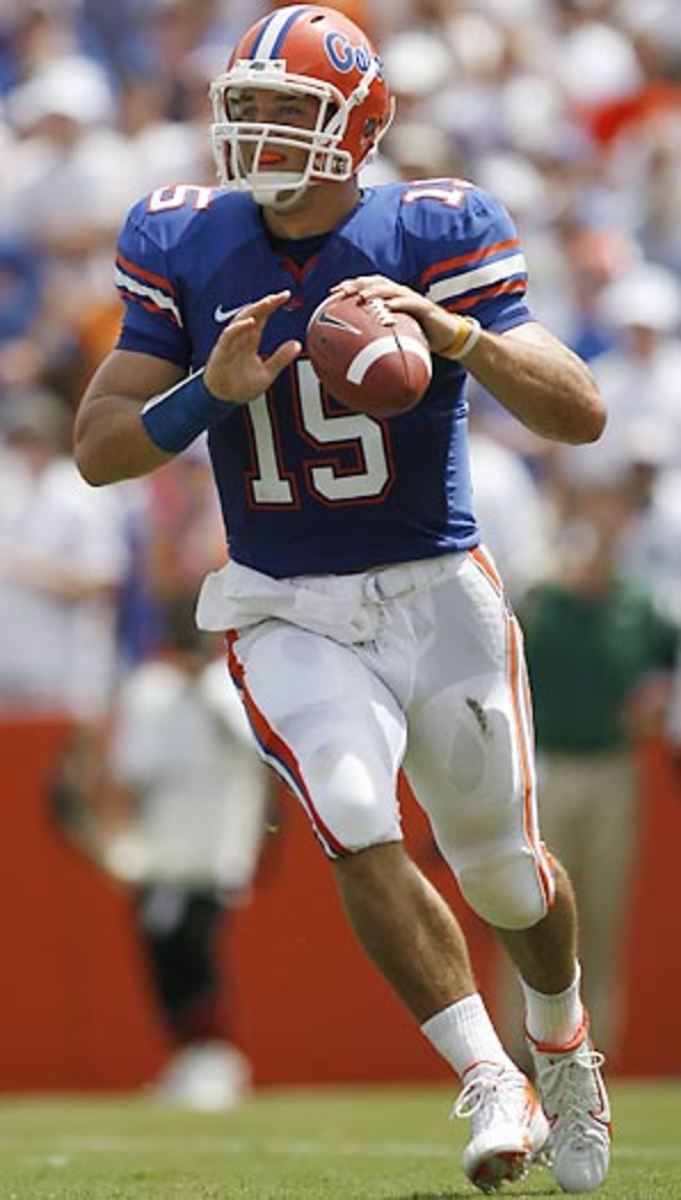
Mythbusters
If you follow college football, you know just how prevalent the spread has become. If you're not familiar with the spread, you should probably get a different hobby.
Finding a story about Tim Tebow or Rich Rodriguez,for instance, that doesn't mention the spread is like finding a Georgia player who doesn't have a rap sheet: They're out there, but you really have to dig. Indeed, this esteemed publication ran a feature in its season preview examining the spread's origins and impact around the country, but truth be told, SI has always been at the forefront of spread-coverage. In 1968, Arkansas head coach Frank Broyles told SI's Dan Jenkins, "If we just spread people out and let the quarterback drop back and throw like the pros, you could play a consistent defense. But now you've got teams with two split receivers, with runners and with quarterbacks who can run the option as well as throw. This simply generates more offense than any defense can handle." (Quick aside: the fact that Broyles and Jenkins were talking offensive schemes during that chaotic year in our country is strangely reassuring -- no matter how nutty the outside world gets, college football is a constant.)
In its simplest terms, a spread offense is any offensive scheme that features at most one running back and four or five wide receivers and is predicated on the quarterback being a threat to pass or carry the ball himself. There are dozens of variations, many of which have their own cute little nicknames, but ultimately, the spread is any formation that tries to "spread" the field (we know, you would have never guessed it from the name). Contrast this with non-spread offenses, which apparently try to constrict players into one tight, easily tackled bunch.
Some people believe the spread's popularity stems from the fact that the name reminds corpulent sportswriters of food. But the cold hard reality is this: The spread offense isn't some newfangled form of play-calling wizardry -- it's simple, basic football, and it's been around for quite a while.
There's not much new or avant-garde about it. There are only so many ways you can legally line up 11 guys on the line of scrimmage. From the beginning of the sport's existence, the idea on offense was to get your most talented players the ball, create the biggest mismatches and the greatest amount of open space with which to work. The spread is just the latest slight variation on all the great offensive schemes throughout history, from the Run 'n Shoot to the Fun 'n Gun to the Ben 'n Jerry's.
Mouse Davis is credited with creating the original version of the offense, which featured no tight ends, one or zero running backs and four or five wide receivers. Rodriguez took it to another level when he began employing a version of the spread to protect his undersized quarterback and take advantage of his other athletes. I know, a coach tweaking his game plan to account for his players' size and ability? That's just plain crazy.
Is it really revolutionary to want your QB to have some mobility? To be a good athlete? What will they think of next? Perhaps that those same mobile QBs should have good arms, too? Pure witchcraft. And the purpose of the spread is to spread the field? No. Way.
Spread proponents say the offense has produced a new generation of quarterbacks who are true hybrids, who are just as dangerous carrying the ball as they are throwing it. Steve Young and Randall Cunningham would probably like to have a word with them. It's not unlike basketball's up-tempo "run and gun" craze; Every team in America wanted to play that high-octane style until they realized its success or failure was predicated upon -- you guessed it -- how good its players actually were.
Football is the biggest copycat sport there is, and teams are jumping on the spread-wagon because they see a bunch of national champs (Texas, Florida, LSU) lifting Waterford footballs thanks in part to QBs who could take off and run. But college teams also like to rip off the pros, and so far Vince Young and Alex Smith haven't exactly been sterling missionaries for that offense. Until the Colts and Patriots are setting Peyton Manning and Tom Brady loose for 10 or 15 carries per game, coaches who run pro-style offenses won't be out of work (well, other than Charlie Weis).
The spread is just the latest wrinkle in a constantly evolving-but-basic offensive philosophy: Put your playmakers in the position to make plays. There is nothing new under the sun and that includes the college football world's flavor of the half-decade. The forward pass revolutionized football. The spread offense just made it a little more fun to watch on the weekend.
That's all for this week. Remember: Just because college football fans thinks it's true, doesn't mean it is.
Got a myth you want us to bust? Contact Phil at mythbusters.sportsillustrated@gmail.com.




